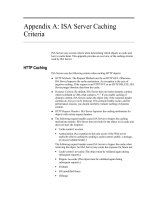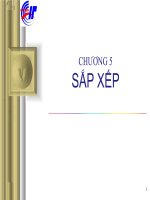Tài liệu Appendix C: SAP Open Information Warehouse pptx
Bạn đang xem bản rút gọn của tài liệu. Xem và tải ngay bản đầy đủ của tài liệu tại đây (719.7 KB, 22 trang )
Report Development Tools C–1
Appendix C: SAP Open Information
Warehouse
Contents
What Is the SAP Open Information Warehouse? ............................................... C–2
Working With OIW Source and Meta Data .......................................................... C–5
Running OIW Reports in Excel........................................................................... C–15
Getting the Most from SAP OIW: Tips & Tricks................................................ C–20
Review .................................................................................................................. C–20
Where to Learn More........................................................................................... C–21
C
In this chapter you will learn:
What the SAP Open
Information Warehouse
(OIW) is
How the SAP OIW is
organized
How to prepare OIW
source and meta data
How to download an OIW
report into Microsoft Excel
Appendix C: SAP Open Information Warehouse
What Is the SAP Open Information Warehouse?
Reporting Made Easy
C–2
What Is the SAP Open Information Warehouse?
The SAP Open Information Warehouse (OIW) unifies the various information systems
within the R/3 System into a single system. It pools various disparate information systems
into a single, easy-to-use “information warehouse.”
You can use the OIW to gain an overview of information units across the R/3 System. With
the OIW you can overcome the boundaries that tend to exist among different information
systems by easily combining particularly relevant information units into queries (for
example, a sales report that combines stock and purchasing data, or a sales report that
includes costing/profit information). All connected information systems automatically
supply business data to the OIW.
Note: The OIW was first delivered with Release 3.1G. It is available free-of-charge to
R/3 customers. Although the OIW is still available, it is widely regarded as the precursor
to the recently introduced SAP Business Information Warehouse (BW). For more
information on the Business Information Warehouse, see chapters 7 through 11.
The OIW was designed to provide users with:
< A single source/toolkit to access different information (for example, logistics, finance,
and costing)
< An easier-to-understand user interface for data extraction and display
< An improved report layout through the use of familiar PC applications such as
Microsoft Excel
The OIW is an open system because it provides a link to standard PC applications. To learn
more about how the OIW establishes a link between the R/3 System and Microsoft Excel,
refer to page C–4.
The R/3 System makes the following source data available to the OIW:
< Basic data in specific areas such as recruitment in HR, personnel administration in HR,
and overhead cost controlling in CO
< Some secondary data such as other areas of FI and CO (refer to OSS note 82836)
< Information structures created and used by the Logistics Information System (LIS)
Appendix C: SAP Open Information Warehouse
What Is the SAP Open Information Warehouse?
Report Development Tools
C–3
Basic Terminology
OIW Information Catalog
The OIW information catalog defines which data and access paths the OIW can retrieve. The
customer can individually change the contents of the OIW information catalog when
customizing the OIW. Generally, the OIW does not maintain its own data stores. It only
holds links to certain data sources in the R/3 information systems.
Before starting to use the OIW, make sure that the OIW customizing has been done in
the R/3 System. The OIW Frontend will not work if the OIW information catalog is still
empty.
OIW Browser
The OIW Browser is a standard dialog in the OIW Frontend for Microsoft Excel (see page
C–4 for more information) that allows queries to be defined and modified. The OIW
Browser shows all of the information objects that are currently available in OIW. It also
allows the current definition of each of the queries to be viewed. Information objects can be
copied (using drag and drop) from the OIW Browser into a query.
The OIW Browser performs the following tasks:
< Reads the OIW information catalog and displays it as a hierarchical listing.
< Allows the user to define a query by inserting (or moving or deleting) columns and
selections.
< Keeps track of the query’s current definition and displays it to the user.
< Constantly updates the OIW information catalog’s display so that only the selected
information, which fits into the query, is displayed.
Information Object
An information object is a unit of information in the OIW Catalog (for example, material,
plant, customer, and so on).
Add-In
An add-in is a supplementary program that helps extend the functionality of Microsoft
Excel. You can use Microsoft Excel’s Add-in Manager to install an add-in. The add-in is
automatically activated each time Excel is started.
Data Sources
Data sources are sets of information objects in the OIW Catalog that can be used in
combination with the queries. A query on the OIW is valid only if there is at least one data
source in the OIW that combines all of the information objects present in the query. Just like
the information objects, each data source is also recorded in the OIW Catalog.
Appendix C: SAP Open Information Warehouse
What Is the SAP Open Information Warehouse?
Reporting Made Easy
C–4
OIW Frontend for Microsoft Excel
The OIW contains a programming interface to help users connect to external applications.
The OIW Frontend for Microsoft Excel is based on this programming interface. It is
delivered with the SAPgui on the installation CD.
With Microsoft Excel’s add-in capability (In Excel, choose Tools
→
Add-Ins) you can use the
OIW Frontend to construct queries in the OIW and embed them in Microsoft Excel
worksheets.
This linkage to Microsoft Excel offers the following benefits:
< The OIW obtains the answers to queries without requiring you to understand all the
access paths in the R/3 System. To use the OIW for data retrieval, you do not need any
knowledge of the tables, programs, reports, or information systems, etc.
< Direct and easy access to the layout and formatting options (for example, fonts, columns,
graphics, etc.) available in Microsoft Excel. The OIW reports in Excel can be maintained
with all the functions of Excel, Microsoft Office, and Visual Basic.
The OIW Frontend for Microsoft Excel is implemented in the Add-in SAPOIW. When this
add-in is opened—either manually or automatically—the OIW Frontend becomes active in
Microsoft Excel.
You can use the OIW Frontend toolbar or the menu options to embed new OIW queries
in Microsoft Excel worksheets as array functions and to change existing embedded
queries.
When calculating the embedded array functions, the OIW Frontend automatically tries
to call the corresponding OIW queries in the R/3 System. The results of these queries
then appear as values of the array functions in the Excel worksheet.
Since the queries are updated whenever the Excel “recalculation” function is executed,
you can be sure that your data is consistent as long as the automatic calculation mode is
selected in Excel and the OIW add-in is active.
The OIW BAPI
The OIW Frontend uses a normal SAP Business Application Programming Interface
(BAPI) to read the OIW information catalog and to retrieve data. Therefore, external tools
can access the same data that the OIW Frontend can deliver as a normal BAPI according
to SAP’s Business Framework Architecture.
The OIW offers two BAPI’s with the following methods:
< OpenInfoWarehouse.GetData: Executes a query and delivers back the results.
< OpenInfoWarehouse.GetCatalog: Reads the OIW information catalog.
Appendix C: SAP Open Information Warehouse
Working With OIW Source and Meta Data
Report Development Tools
C–5
Working With OIW Source and Meta Data
In this guided tour you will learn how to:
< Define the OIW meta data.
< Display the OIW information catalog.
< Create a custom OIW information catalog.
Guided Tour
Defining the OIW Meta Data
The OIW meta data represents
information about all available source
data that can be later transferred to
the OIW Browser in Microsoft Excel.
As not all available meta data might
be used, specify only the data you
want to use later.
1. From the SAP main menu, choose
Tools
→
Business Engineer
→
Customizing, then Implement.
projects
→
SAP Reference IMG.
2. In the implementation guide
(IMG), select the area Cross
Application Components, then the
folder Open Information Warehouse.
3. To start maintaining the OIW meta
data, choose the Execute icon to the
left of Maintain OIW metadata.
2
3
Appendix C: SAP Open Information Warehouse
Working With OIW Source and Meta Data
Reporting Made Easy
C–6
In this example, the following OIW
meta data is needed:
< Cost Center Accounting
< Logistics (information structures
containing sales and inventory
data)
< Personnel Management
4. In the Controlling section, select
Cost Center Accounting.
5. In the Logistics section, select
Standard info structures to include
all standard LIS structures (S001-
S499).
6. From the Administration area in the
Personnel Management section,
select Standard fields.
7. Choose Execute.
This screen shows the requested meta
data for the data source.
8. To view the list of the data sources
of the OIW meta data, choose
Display on the previous screen.
9. Choose Enter.
4
5
6
7
8
9
Appendix C: SAP Open Information Warehouse
Working With OIW Source and Meta Data
Report Development Tools
C–7
Display Standard OIW Information Catalog
The R/3 System contains a standard
OIW information catalog based on the
main components in Financial
Accounting (FI), Controlling (CO),
Logistics Information System (LIS),
and Human Resources (HR).
1. To display the standard OIW
information catalog, choose the
Execute icon next to the
appropriate line.
The standard OIW information
catalog includes most of the
characteristics and key figures.
2. Choose Expand
to display the
hierarchy of each node.
1
2
Appendix C: SAP Open Information Warehouse
Working With OIW Source and Meta Data
Reporting Made Easy
C–8
Creating a Self-Defined OIW Information Catalog
If you need data from nonstandard
information sources, such as self-
defined LIS structures, you must
create your own OIW information
catalog.
1. Choose Maintain self-defined OIW
information catalog.
You can name and create your own
OIW information catalog.
2. Choose Edit rename to give a
unique name to your custom OIW
information catalog. You can use
any names and hierarchy structure
to organize the objects and key
figures.
3. Choose Create nodes to define the
nodes for your OIW information
catalog.
4. Enter the names of the nodes in
the Create Node popup window.
5. Choose Create.
2
3
4
5
1









